Why you can trust TechRadar
We spend hours testing every product or service we review, so you can be sure you’re buying the best. Find out more about how we test.
TCL QM7K: Two-minute review
The TCL QM7K is an impressive TV. Even though it’s a bit more expensive than the TCL QM6K I recently reviewed, it fixes the main issues I had with that model. Specifically, the audio quality is much improved. It also offers quite a bit more brightness, which particularly benefits high dynamic range content, and there are more local dimming zones in its mini-LED backlight.
The question of whether the TCL QM7K is the best TV for you will depend on if you’re comfortable paying the extra cash for the improvements it brings. TCL’s Halo Control tech does a great job of keeping backlight blooming effects – an issue even with the best mini-LED TVs – at bay, and the TV’s fast, 144Hz refresh rate (with the potential to effectively double that rate) is a great feature, though both are also available on the cheaper QM6K. In fact, everything outside of the better audio and brightness is basically the same on the QM6K.
The improvements the QM7K brings are ultimately worth the $500 price difference (that amount will vary a bit between screen sizes). But for me, the cheaper QM6K’s lower screen brightness wasn’t a dealbreaker, and adding one of the best soundbars will bring an audio quality improvement to just about any TV.
Still, the TCL QM7K is a high-quality TV with a great-looking picture that’s easy to use. It’s also packed with features, whether you want to watch a movie or boot up your PlayStation 5.
TCL QM7K review: Price and release date
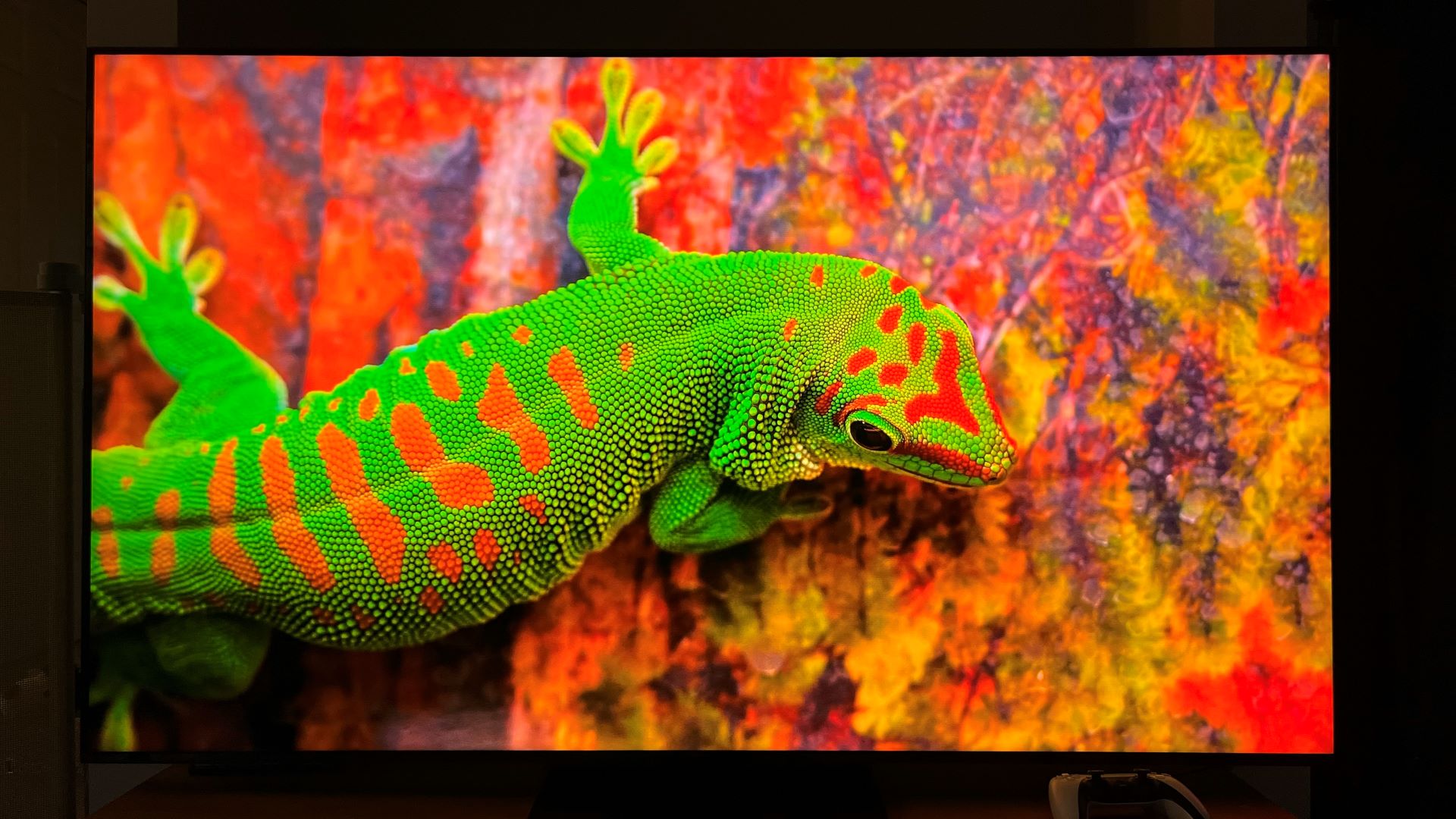
- Release date: March 2025
- 55-inch: $1,299.99
- 65-inch: $1,499.99
- 75-inch: $1,999.99
- 85-inch: $2,499.99
- 98-inch: $4,999.99
- 115-inch: $19,999.99
The TCL QM7K is a step up from the brand’s newly released QM6K series TVs. Some of the sizes, specifically the 98-inch and 115-inch, are not yet available. TCL QM7K series TVs are only sold in the US.
The QM7K’s step up in price over the QM6K series reflects features such as the higher number of local dimming zones (a maximum of 2800 versus 500), improved brightness, and Bang & Olufsen-tuned built-in speakers.
TCL QM7K review: Specs
Screen type: | mini-LED |
Refresh rate: | Up to 144Hz |
HDR support: | Dolby Vision IQ, HDR10+, HDR10, HLG |
Audio support: | Dolby Atmos, DTS Virtual:X |
Smart TV: | Google TV |
HDMI ports: | 4 (2x HDMI 2.1) |
Built-in tuner: | ATSC 1.0 |
TCL QM7K review: Benchmark results
TCL QM7K review: Features
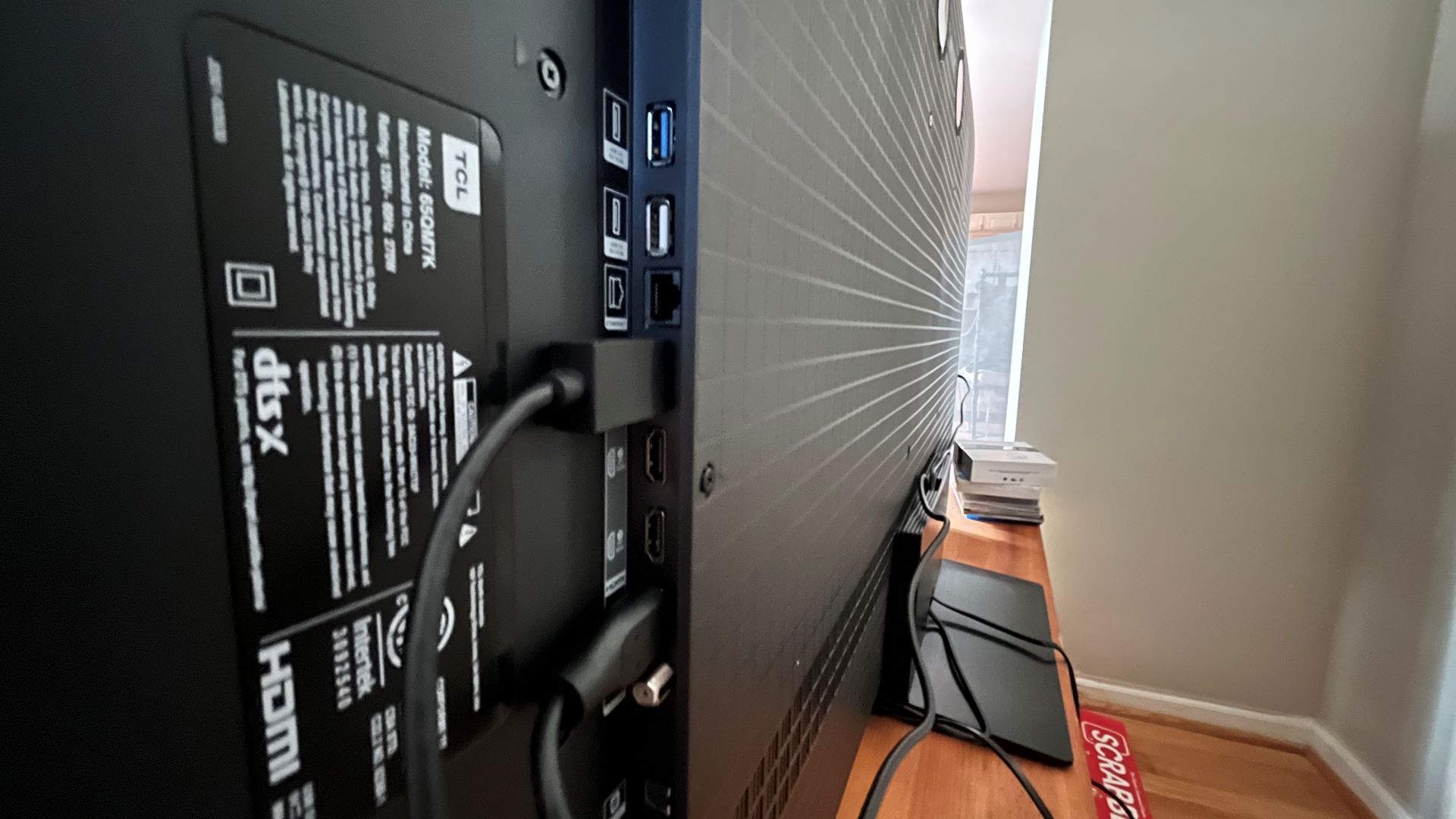
- Dolby Vision IQ effectively adjusts the picture for bright rooms
- Picture presets include IMAX Enhanced and Filmmaker Mode
- Hands-free voice control
While I’ll go into a little more detail regarding Halo Control in the next section, it’s worth mentioning that TCL’s proprietary technology for precise dimming is featured on the QM7K series, and it’s probably the most important one for this TV. I’ll go into the QM7K’s impressive HDR performance there as well.
But that’s just the tip of the iceberg here. Dolby Vision IQ is one of my favorite features for this TV (also available on the cheaper QM6K). My viewing room gets a lot of ambient light from windows, and watching TV during the day can sometimes be an exercise in frustration. But the Dolby Vision IQ feature minimizes the effects of ambient light by adjusting the TV’s brightness accordingly, so you can see the picture regardless of whether the sun is shining or not.
There’s also Dolby Vision (the non-IQ version of the feature), which functions similarly with Dolby Vision content, automatically adjusting contrast to give the best results based on the image being shown, whether it’s sports or a brooding Batman movie.
If you don’t want the TV to intelligently (the word you’ll see in the menu for these features) adjust the screen, there are plenty of picture modes available. There are the basic ones like Movie and Sports, but there’s also an Imax Enhanced mode and a Filmmaker Mode meant to provide the most accurate picture when watching movies.
Lastly, I would be remiss if I didn’t mention that there’s also hands-free voice control using far-field mics if you don’t feel like reaching for the remote.
TCL QM7K review: Picture quality
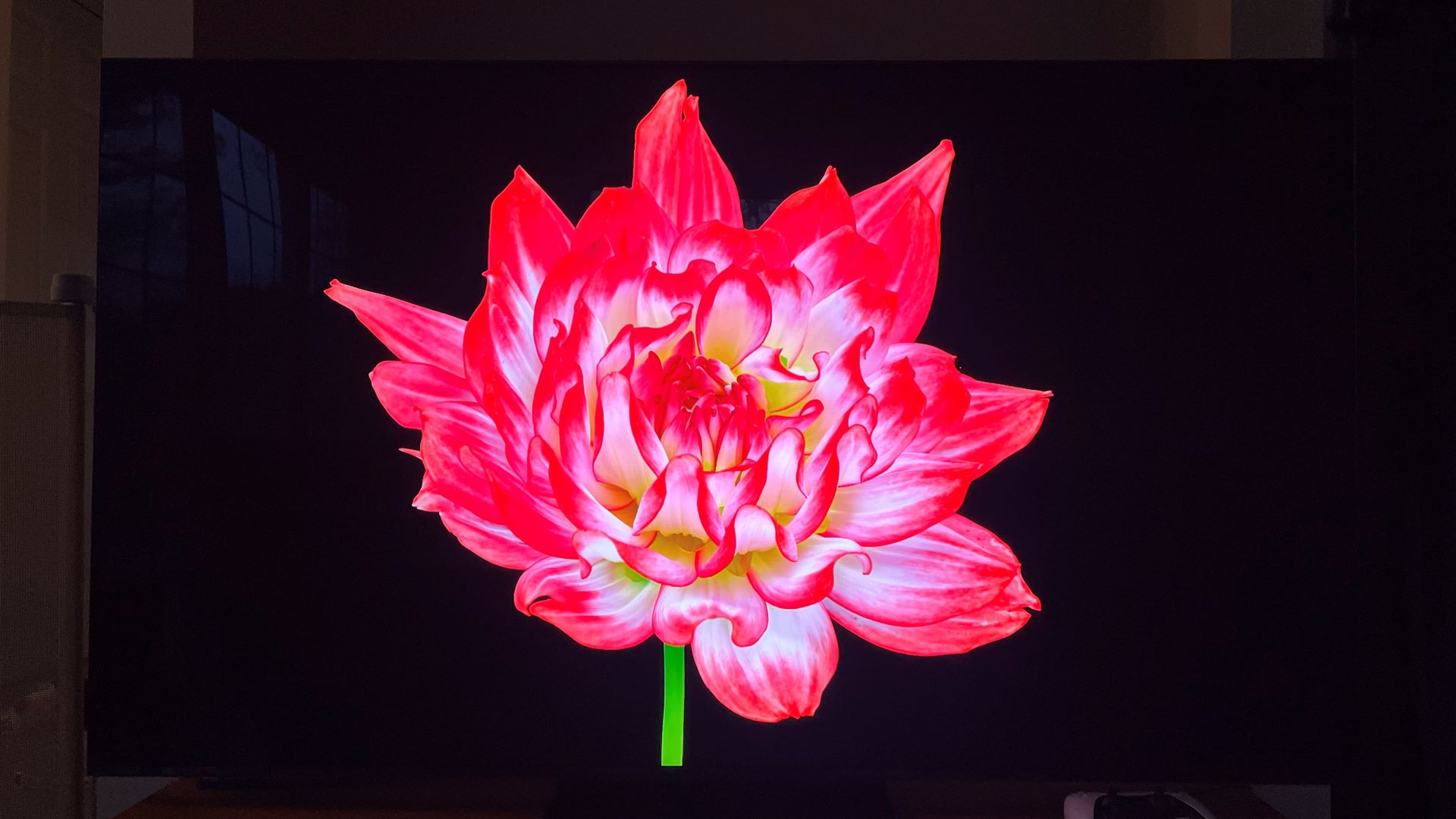
- Impressive HDR brightness
- Halo Tech minimizes blooming
- Some minor vignetting
The TCL QM7K boasts some solid benchmarks. To start with, its brightness is one of the biggest upgrades over its little brother, the TCL QM6K. In Filmmaker Mode, peak HDR brightness on a 10% white window pattern was measured at 1,733 nits, and 100% fullscreen brightness at 536 nits.
Those same brightness measurements made in the TV’s Standard picture mode were even higher at 2,350 and 640 nits, respectively.
Color gamut coverage is good as well, but not quite the smae upgrade as the brightness. We benchmarked it at 96.9% for UHDA-P3 and 79.2% for BT.2020, both better than the QM6K and Hisense U7N. It’s also worth mentioning that the QM7K’s color accuracy averaged out to a very respectable 1.4.
The Halo Control Technology that the TCL QM7K shares with the QM6K is a huge help in minimizing bloom, an artifact of mini-LED and LED-backlit TVs, where you see a halo effect in dark parts of the screen positioned next to bright sections. The QM7K series has up to 2,800 dimming zones compared to 500 on the QM6K series, and regardless of what I watched, high-contrast images had crisp definition.
Cinematic fare like Hero, The Batman (2022), or really any movie with great cinematography came to life on the QM7K, its brightness, comprehensive HDR support, color gamut coverage, not to mention precise dimming control contributing to detailed yet vibrant images.
The only real issue I encountered was that I experienced some very slight vignetting in the corners of the screen, though it was more minimal than what I saw when I reviewed the TCL QM6K. And despite the QM7K’s high brightness, I still experienced screen glare when watching during the daytime with sunlight coming through the windows.
- Picture quality score: 4.5/5
TCL QM7K review: Sound quality
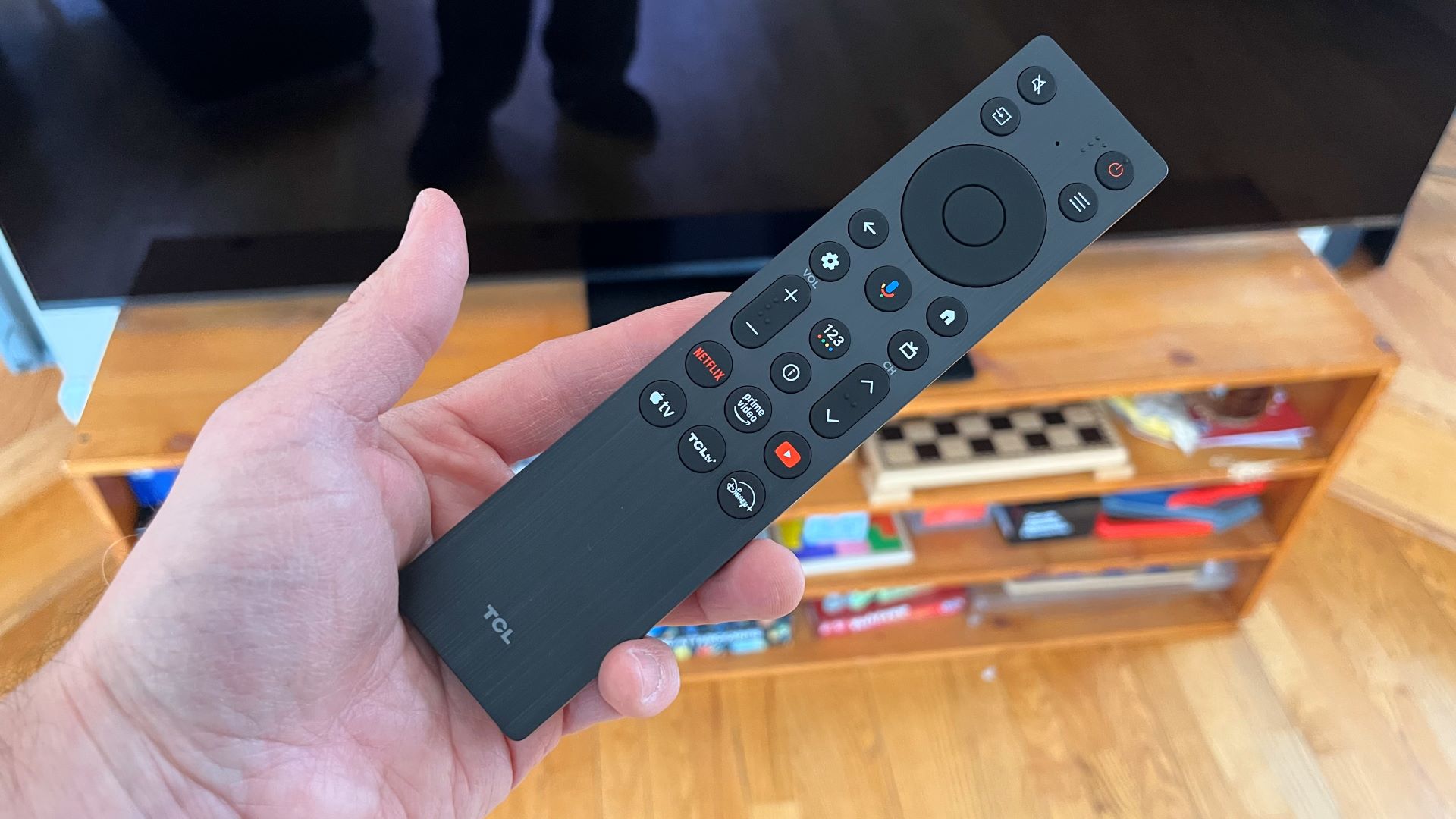
- Audio by Bang & Olufsen
- Limited bass
- Soundstage is good if a bit narrow
Having just reviewed the TCL QM6K, the QM7K’s sound quality is another big upgrade. The 40W system is described by TCL as “Audio by Bang & Olufsen,” and since Bang & Olufsen makes solid-sounding products, that usually bodes well.
The QM7K supports Dolby Atmos and DTS Virtual:X, and is also IMAX Enhanced. There are several sound modes, including Bang & Olufsen’s proprietary Beosonic EQ profile that allows for some fine-tuning. When this is selected, a dial appears on the screen with a particular sound profile at the top, bottom, and sides: bright, energetic, warm, and relaxed (clockwise from the top). You can also navigate a cursor anywhere within the dial to create some combination of these sound profiles.
When I reviewed the QM6K, I found there to be a strange dip in the frequency response that gave the sound a slightly artificial quality. Luckily, the QM7K doesn’t have that. The mids are nice and full so that vocals have the kind of richness one would expect when listening to music or watching a movie, and the high-end has both clarity and detail. The bass is fairly limited, but that’s to be expected with any system that doesn’t have larger speakers, such as a TV.
In The Batman (2022), a scene where Selina Kyle is breaking into a safe near the beginning of the movie illustrates a lot of what’s going on with the QM7K’s sound. The sounds of her drill and the turning of the safe’s dial were heard clearly and sounded crisp. And the sound of her hand-to-hand combat with Batman had plenty of impact, as did the dialogue. The TV’s full mid-range also benefited music listening.
The QM7K’s soundstage is good, with elements in soundtracks that are supposed to be on the left or right (or moving from one side to the other) spatially well-defined but still fairly narrow, as it is physically limited by the placement of the speakers.
In the end, the QM7K’s audio quality is very good – it’s just not the full movie experience you would get if it were paired with a good soundbar.
TCL QM7K review: Design

- Pedestal stand can be adjusted for height
- Ports include two HDMI 2.1 with 144Hz support
- No dedicated play/pause button on remote
The TCL QM7K looks like most contemporary TVs, so you’re probably not going to make a buying decision based on how it looks. The bezel around the screen is fairly thin, making this a svelte-looking TV from the front, and a slight angle allows the dual ports housing the speakers some clearance if you were to wall mount it.
A pedestal stand keeps the TV stable, and it can also be connected at a range of heights so you can raise it a little higher if you want to keep the bottom of the screen from being blocked by a soundbar.
The back of the stand also has a cover that easily slides up and off, revealing some rudimentary cable management, which allows for a cleaner look, especially with the included cable clips. There’s not a ton of space here, however, so if you have a ton of devices plugged into the TV, you might not be able to route all the cables through the back of the stand.
Speaking of plugging devices in, all the ports except for the power are located on the right side of the TV and are angled so that any cables sit flush against it. This is a simple touch that helps keep things looking tidy, especially if you plan on a wall-mount installation. Also worth noting is that the different HDMI ports have their maximum resolution and refresh rate listed next to them – important for gamers!
The remote for the TCL QM7K has all the usual controls, from the directional wheel and center button used to select things to the ones that take you directly to apps like Netflix and Prime Video. There’s also a dedicated button for the TV’s voice assistant. Sadly, there’s no dedicated play/pause button, which means you have to press the directional wheel to bring up the interface and then press the center button again to actually pause playback.
TCL QM7K review: Smart TV and menus
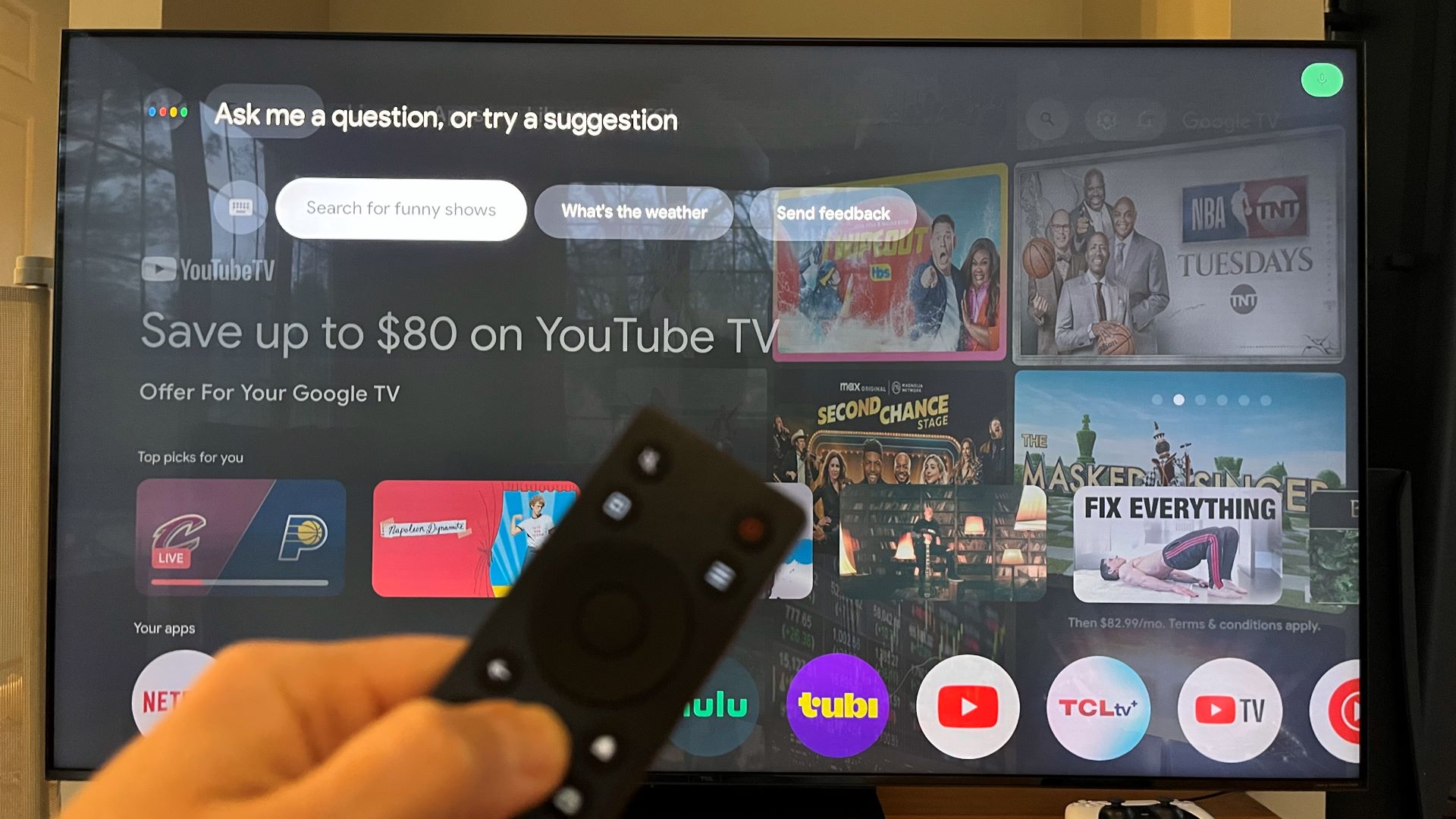
- Home page displays a good range of content
- Google account login required to fully unlock features
- Hands-free voice control
The TCL QM7K uses Google TV as its smart TV interface. This has a large, cycling tile that takes up much of the screen with featured content, followed by various rows of tiles with suggested content from various services, a list of apps, and more. It’s a nice layout, only hampered by the fact that not all content seems to be indexed on the home page. (I would love to see suggestions from my Criterion Channel or Mubi app pop up next to YouTube and Max ones.)
As with most smart TV interfaces, there’s plenty of live and free ad-supported content available without needing an additional subscription. This isn’t up to the quality level of what you get from something like Netflix, but it’s not all Sharknado knock-offs. I came across Nip/Tuck, Mr. Bean, and The Illusionist after just a quick scroll. Of course, there’s plenty of Ed Wood-level content available as well.
To get the most out of the interface, you need to first log in to your Google account to set it up. If you’re worried about privacy, this is a requirement that might seem as invasive as it is necessary. It didn’t help that a portion of the featured tiles were ads as opposed to just highlighted content that I already have access to, including an ad with a QR code for ordering pizza on the front page.
As far as the menu diving for TV functionality goes, it’s straightforward and baked into the Google operating system, so you can get to the settings either via the remote or navigating through the home page. It’s also very easy to get deep into fine-tuning the screen, sound, and more to your liking without getting lost.
- Smart TV & menus score: 4/5
TCL QM7K review: Gaming
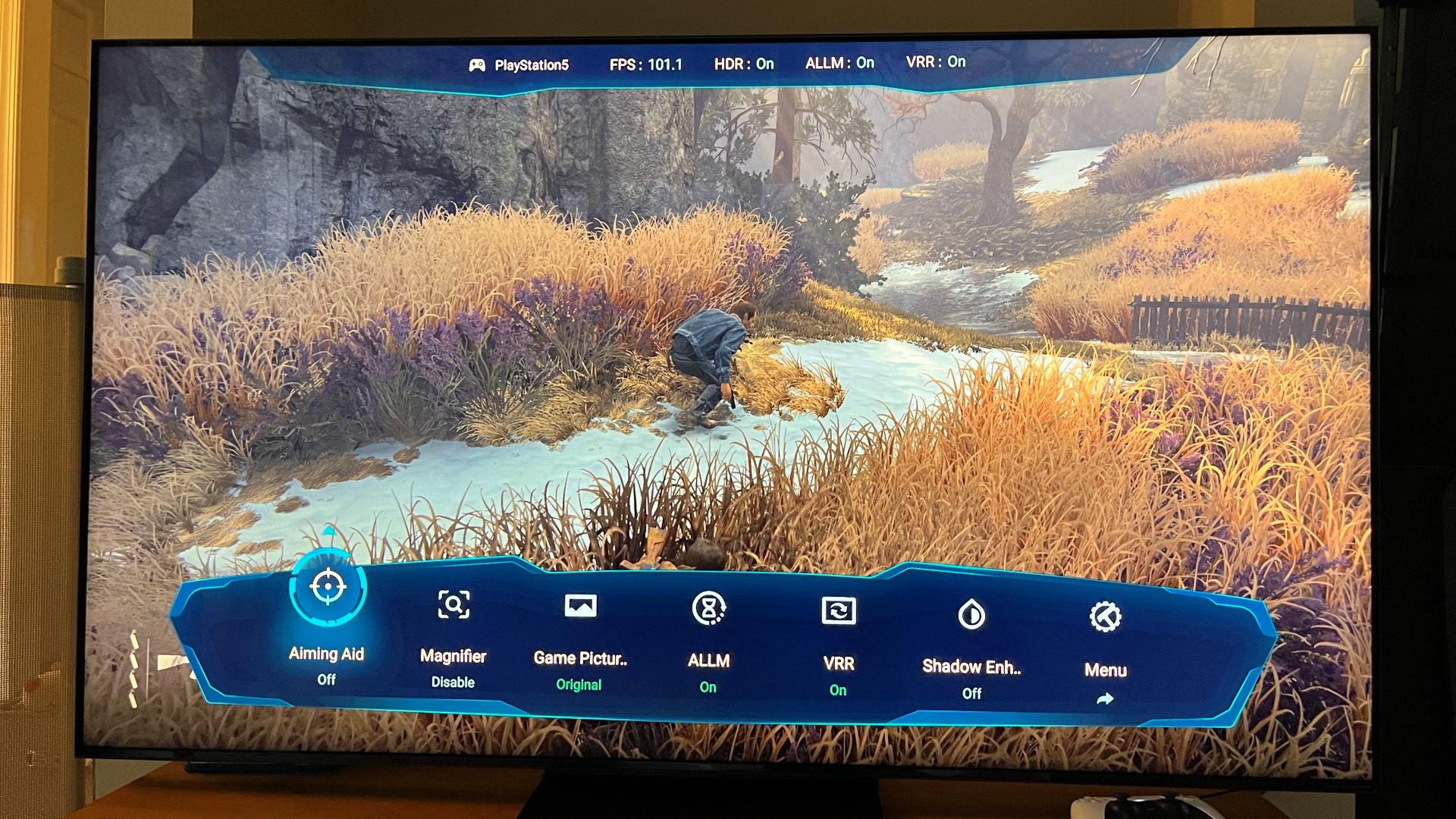
- 4K 144Hz support plus VRR game accelerator
- Smooth and clear action
- Dedicated Game Master settings menu
Pricier TVs like this one need to appeal to gamers, and TCL has succeeded on that front. Two of the HDMI inputs support 4K 144Hz, so you get smooth gameplay even when the game is going at a breakneck speed, as I did when running away from or through crowds of zombies in Dead Island 2. It can boost up to a 288Hz variable refresh rate (240Hz on the 55-inch model) at 1080p resolution.
If needed, there’s a game-centric settings interface called the “Game Master” menu that you can easily pull up to display a refresh rate in the corner, add an aiming crosshair, turn on the VRR, and boost HDR content where applicable.
All in all, using the TCL QM7K is a treat for gaming. The picture quality is sharp and vibrant, especially when you can turn on HDR, and the action is as smooth as one could hope. Input lag is 13.1ms, which is higher than what you get with TVs from Samsung and LG, but it still feels immediate and responsive when gaming.
TCL QM7K review: Value
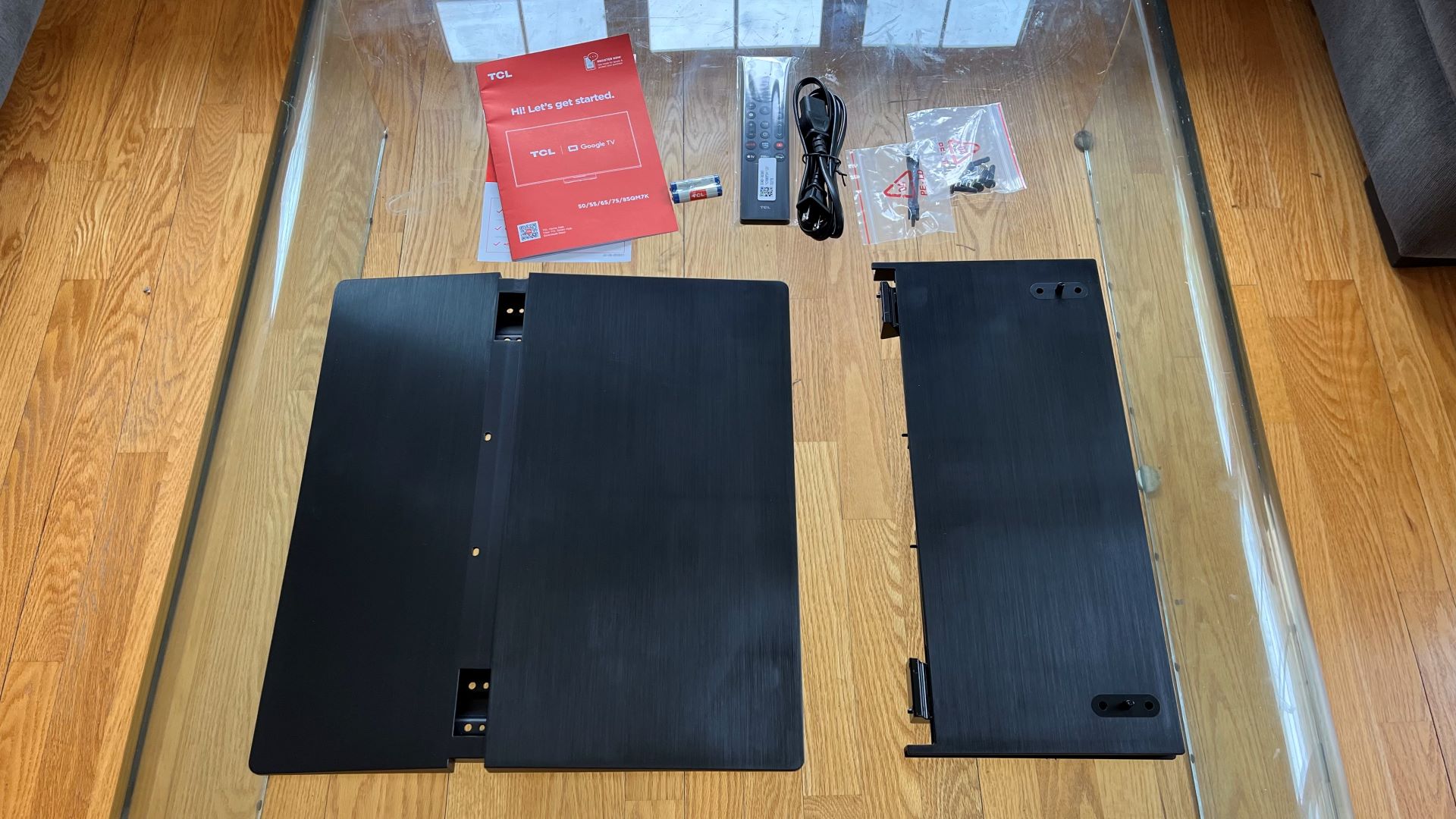
- Not cheap, but still a good value proposition
- Cheaper than other “mid-range” TVs
- Better brightness than other TVs in its price range
The TCL QM7K TV is not the same fantastic value proposition as the TCL QM6K, but it’s still a very good value.
A good point of comparison would be the Hisense U7N, a competent TV that punches above its weight. The QM7K is better than the Hisense U7N all around, with better brightness and significantly better audio quality. However, the QM7K is also more expensive.
Should I buy the TCL QM7K?
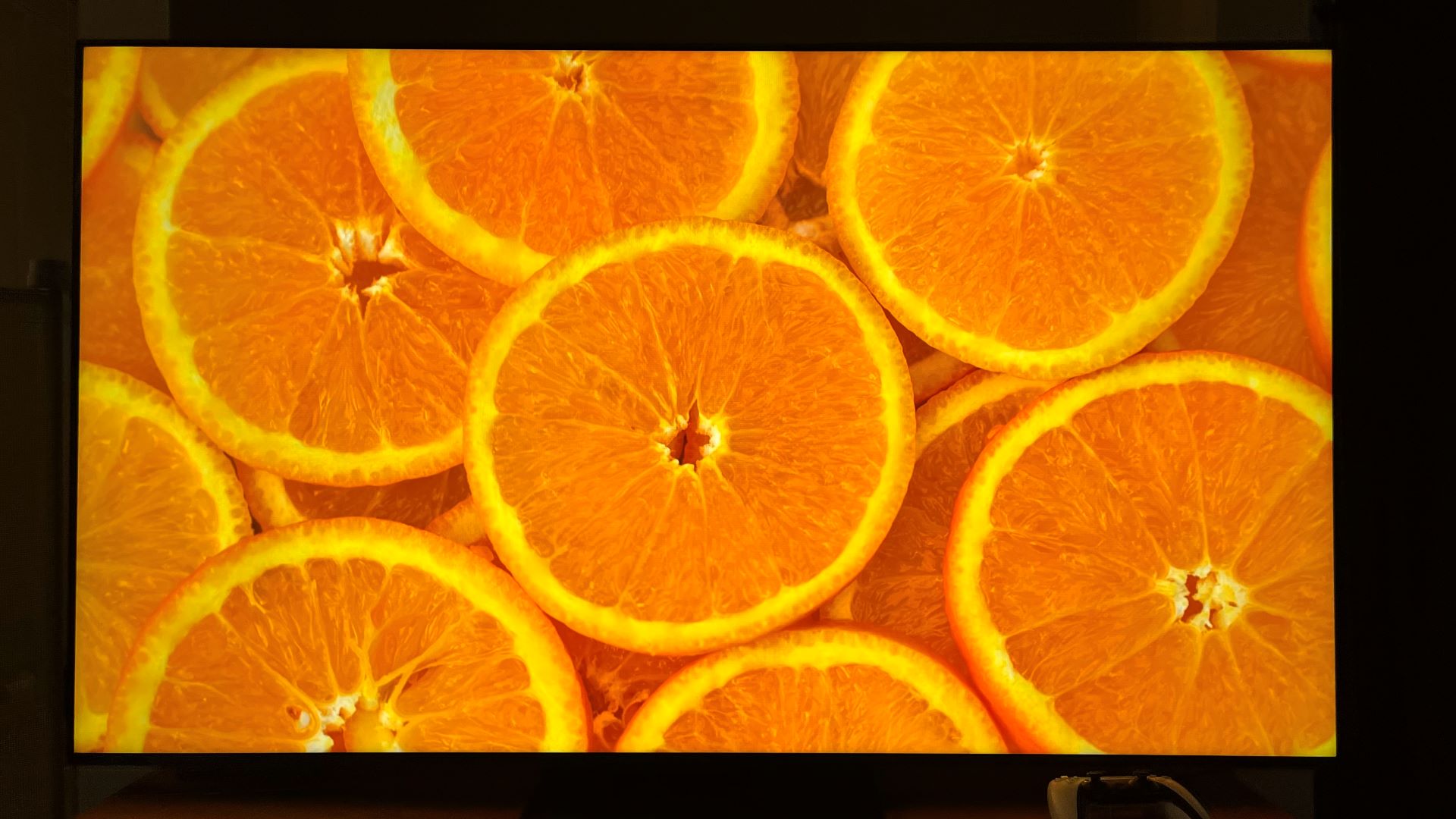
Attributes | Notes | Rating |
|---|---|---|
Features | Dolby Vision IQ and HDR10+, along with Halo Control, VRR, and more, make this a feature-filled TV | 4.5/5 |
Picture quality | The TCL QM7K’s picture is, for the most part, phenomenal, with strong contrast, minimal blooming and very good color gamut coverage, but also screen reflections | 4.5/5 |
Sound quality | The TV’s Bang & Olufsen audio isn’t great on bass or soundstaging, but the overall sound quality is more than good enough | 4/5 |
Design | The remote is missing a dedicated play/pause button, but this TV’s design is otherwise impeccable. The adjustable stand is a bonus | 4.5/5 |
Smart TV and menus | Setting up and navigating the Google TV interface is straightforward and intuitive, though you’ll need to log in with a Google account for some features | 4/5 |
Gaming | Fast refresh rates and some useful gaming-related features make this TV a treat to game on | 4.5/5 |
Value | It’s a bit pricier than other TVs, balancing the line between value and performance | 4.5/5 |
Buy it if…
Don’t buy it if…
Also consider…
| Header Cell – Column 0 | TCL QM7K | TCL QM6K | Hisense U7N | TCL QM851G |
|---|---|---|---|---|
Price (65-inch) | $1,499 | $999 | $999 | $897 |
Screen type | mini-LED w/ QLED | mini-LED w/ QLED | mini-LED w/ QLED | mini-LED w/ QLED |
Refresh rate | Up to 144Hz | Up to 144Hz | Up to 144Hz | 120Hz |
HDR support | Dolby Vision IQ/HDR10+/HDR10 | Dolby Vision IQ/HDR10+/HDR10 | Dolby Vision IQ/HDR10+/HDR10 | Dolby Vision IQ/HDR10+/HDR10 |
Smart TV | Google TV | Google TV | Google TV | Google TV |
HDMI ports | 4 (2x HDMI 2.1) | 4 (2x HDMI 2.1) | 4 (2x HDMI 2.1) | 4 (2x HDMI 2.1) |
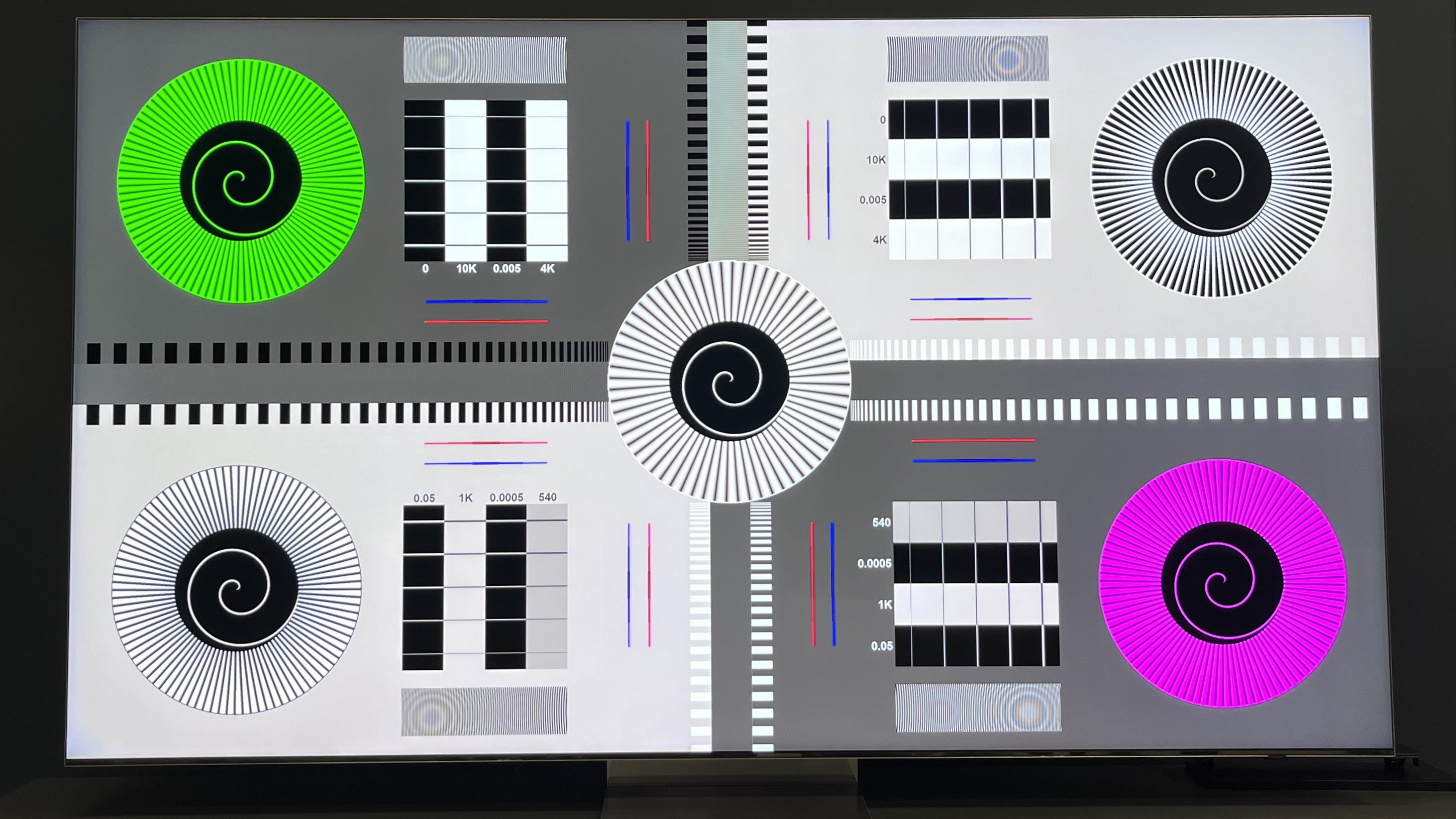
How I tested the TCL QM7K
- I used the TCL QM7K TV for two weeks
- Tested with TV, movies, music, and games
- Benchmark measurements conducted by Future US testing lab
I used the TCL QM7K TV regularly for several weeks, testing it with movies, shows, sports events, and games. I tested the various features, such as Dolby Vision IQ, to see if they work as advertised. I also spent time listening to the TV’s audio and watching reference clips to evaluate the picture quality.
After spending some time with this TV, it’s clear that it’s aimed at those looking for a premium experience but at a lower price than a comparable Samsung or LG TV.
I’ve tested plenty of tech gear over the years from laptops to keyboards and speakers, and have been able to apply my expertise toward giving an honest and fair opinion, not to mention a critical eye, to any product I test.
You can read an in-depth overview of how we test TVs at TechRadar at that link.







Leave a Comment
Your email address will not be published. Required fields are marked *